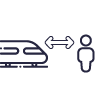In order to have fewer incidents and fewer lives lost, it is important to encourage responsible attitudes and to encourage safe behavior among citizens of all ages regarding the observance of the rules, signs and warnings in the interaction with the railway and trains.
Railway safety in Albania is guaranteed by the new Railway Code. The Code stipulates the use of Common Safety Methods (mandatory in EU countries) for the safe operation of trains. Common Security Methods describe how security levels should be implemented and how goals and compliance with other security requirements should be achieved.

The railway today is often used by the locals as a short walkway for pedestrians and vehicles, as a playground for children or as a pasture for livestock and pets.
The protective fence of the Durrës-Tirana-Rinas line will enable:
The railway fence will close all unauthorized crossings. Authorized crossings will be positioned in accordance with the possibilities of alternative routes. Railway canals and bridges will create acceptable opportunities for animal movement.
LEVELS CROSSINGS are critical points in the railway network, as they represent an inherent risk to the safety of road and railway users.
Historical data show that any type of protection is better than nothing, only manual systems with level crossing protection beams reduce the risk of an accident to zero.
There are two types of level passes:
Level crossings within station boundaries
Level crossings that are outside the boundaries of the stations, on the open line

SIGNAGE AND SINJALING FOR RAIL/ROAD USE
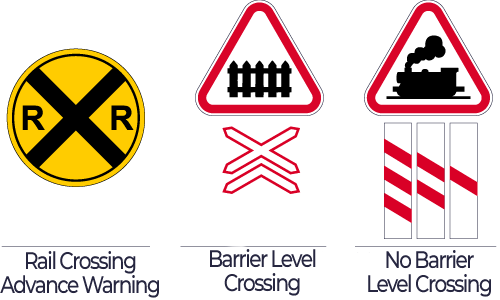
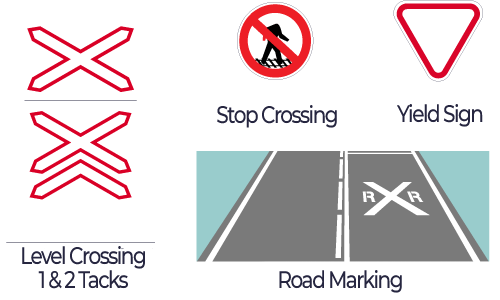
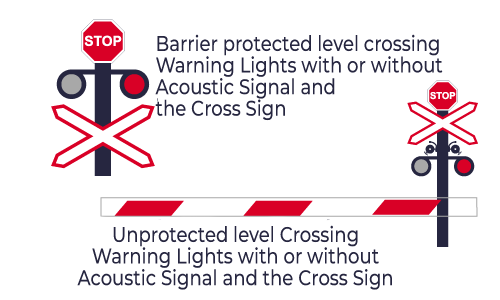
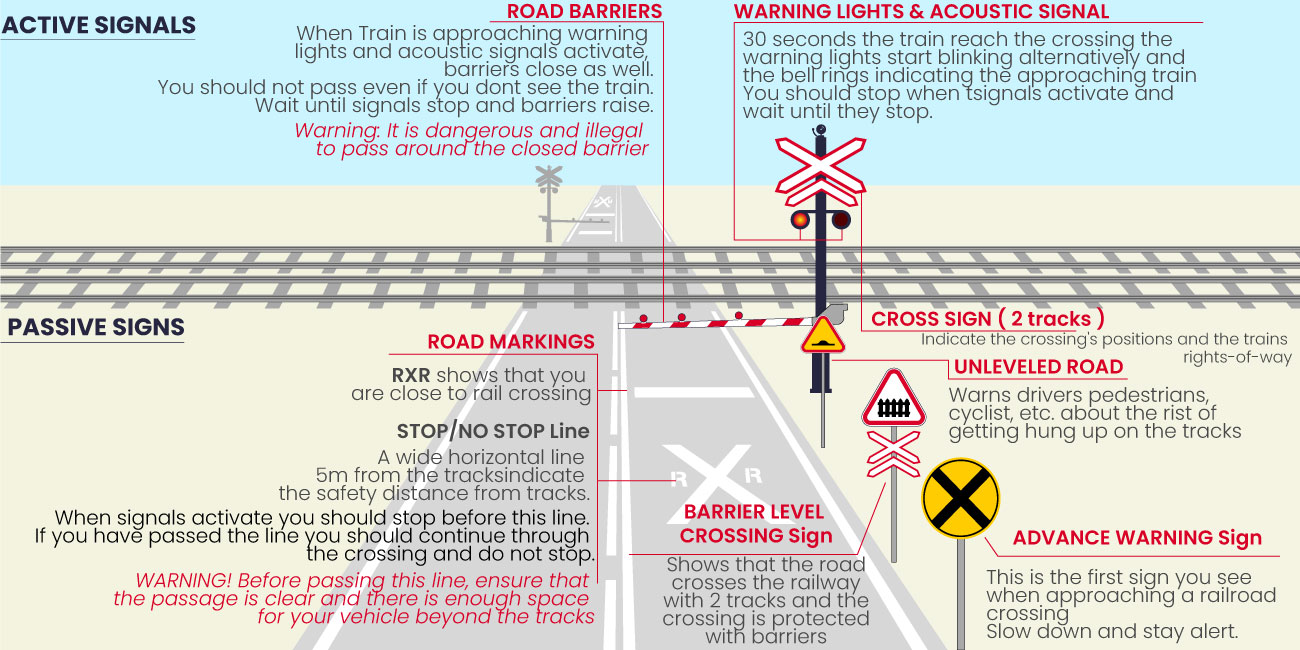
Whether you are walking, driving or riding a motorcycle, or riding a bicycle, skating rink, monopath, wheelbarrow or wheelchair, stay close to the rails, trains or railway junctions, WATCH and WORK A LOT. Your safety near the rails is only related to knowing and enforcing the rules.



FOR PEDESTRIANS
STAY AWAY FROM RAILS!
Never walk, play, ride a bicycle, motorcycle or vehicle along the tracks. It is difficult to judge the distance or speed of a passing train.
RESPECT SIGNALS SIGNALS
Follow all rules indicated by warning signs and equipment. Before crossing the tracks, look on both sides and hear if the train is approaching. If the train is coming, or the signals are activated, stop behind the gate or 5 m away from the tracks and wait for the train to pass. Pass only when the signals have stopped and you are sure that no other train is approaching.
KEEP SAFETY DISTANCE
Trains exceed the width of the tracks by up to 1 m on each side. They can transport cargo that is wider than wagons; you can also be hit by chains, ropes or by the whirlpool if you are too close. Respecting the safety distance saves your life.
SAVE THE RAILWAY PROPERTY
The track, tunnels and bridges are the property of the Railway. Using them for other purposes by humans is not only very dangerous but also punishable.
USE ALLOWED CROSSINGS
Always cross the rails at certain crossings. Crossing the rails anywhere else can be deadly. Caution: the train can come from any direction and at any time, there is no set schedule.
STAY VIGILANT
You can not avoid being hit by the train if you do not hear or see it. Trains today run fast and make little noise. Trains blow the horn at checkpoints, or emergencies, but you will not hear it if you have headphones. Do not be distracted by cell phones or other devices when near a rail or crossing
FOR TOOL MANAGERS
LEARN SIGNS AND SIGNALS
Railway signs and warning devices have been installed along roads and at railway crossings to warn drivers and command traffic. They save lives, so you need to know what they show and warn.
STAY VIGILANT
You can not avoid being hit by the train if you do not hear or see it. Do not use your mobile phone or other device while driving, especially near a railway crossing. Trains today are fast and make less noise, so if you get distracted, you are putting your life and the lives of your passengers at risk.
NEVER RACE WITH THE TRAIN
You can not avoid being hit by the train if you do not hear or see it. Do not use your mobile phone or other device while driving, especially near a railway crossing. Trains today are fast and make less noise, so if you get distracted, you are putting your life and the lives of your passengers at risk.
ASSEMBLE THE VEHICLE WHEN IT GETS OFF OR STOPPED ON THE ROLLING STATIONS
A car can break down at any time and if it happens on the railroad tracks, it can be deadly. If your vehicle turns off or gets stuck on the rails, get out immediately with the passengers and stay at least 30 meters away from the rails. Notify the railway company that the vehicle is over the rails (emergency number may be displayed) otherwise call Civil Emergency.
LOOK AND LISTEN FOR THE TRAIN
As you approach the railway crossing, slow down, look and listen on both sides, stop music and conversations, and open windows to better hear oncoming trains. If the train is coming, stop in front of the STOP line, or 5 m from the nearest rail, and wait for the train to pass.
RESPECT SIGNS AND SIGNALS
Follow all rules indicated by warning signs and equipment. In crossings with active equipment, stand until the barriers are raised and the signals stop. Before proceeding, make sure that there are no other trains and that you have a clear view of the rails. If the signals are activated, or the barriers start to lower when you have crossed them, DO NOT STOP! It is better to keep going than to go back. In case of road traffic at the crossing, make sure that there is enough space to cross completely before entering the intersection.
ATTENTION OTHER PASSERS ON THE ROAD
Be aware that cyclists or other wheeled vehicles move more slowly, and may need extra space at a railroad crossing. Also, school buses or other vehicles may need to stop before crossing the railway so you should be prepared to stop.
FOR CHILDREN
USE ALLOWED CROSSINGS
Cross the tracks only in places marked X. Get away as soon as possible if you hear the train honking when you are near the tracks.
STAY AWAY FROM RAILS
Do not stand on rails. When the trainer sees you it is too late to stop. The rails are for the train, not for the games.
RESPECT SIGNALING
Never fall short on the track.
Do not enter or pass inside railway tunnels.
Do not cross or play on railway bridges.
Do not place hard objects on the train tracks – it is dangerous.
Do not play on wagons or cross between them even when the train has stopped.
Do not stone the train as it endangers the passengers.





